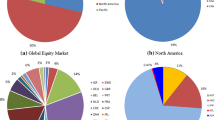Abstract
We analyze the information content in volatility indices of international stock markets regarding current and future market conditions. We find strong negative relationships between changes in volatility indices and current market returns, as well as Granger causality running in both directions. Unfortunately, these correlations cannot be exploited, at least using linear models, to successfully forecast future realized volatility or future returns over long time horizons. Forecasts of future realized volatility obtained from volatility indices are as good as those obtained from historical volatility, but not good enough to be used for risk management. Volatility indices seem to reflect much better current market’s sentiment than any sensible expectation about future market conditions.
Resumen
Analizamos el contenido informativo de los índices de volatilidad de mercados internacionales de renta variable, en relación con las condiciones de mercado actuales y futuras. Encontramos fuertes relaciones negativas entre cambios en los índices de volatilidad y las rentabilidades actuales del mercado, así como causalidad de Granger en ambas direcciones. Lamentablemente, estas correlaciones no pueden utilizarse, al menos utilizando modelos lineales, para predecir con éxito la volatilidad realizada o las rentabilidades futuras, sobre horizontes temporales amplios. Las predicciones de volatilidad realizada futura que se obtienen a partir de los índices de volatilidad son tan buenas como las calculadas a partir de volatilidad histórica, pero no suficientemente buenas para ser utilizadas en gestión de riesgos. Los índices de volatilidad parecen reflejar mejor el sentimiento actual del mercado que expectativas razonables sobre las condiciones de mercado futuras.
Similar content being viewed by others
References
Blair, B., Poon, S.-H. andTaylor,S. J., (2001). Forecasting SP100 volatility: the incremental information content of implied volatilities and high frequency index return,J. Econometrics,105, 5–26.
Bluhm, H. H. W. and Yu, J., (2001). Forecasting volatility: evidence from the German stock market, working paper, University of Auckland (presented at theInternational Conference on Modelling and Forecasting Financial Volatility, September 2001).
Carr, P. and Madan, D., (1998). Towards a theory of volatility trading, in R. Jarrow, ed.,Risk Book on Volatility Risk (New York).
Deutsche Borse, (2005).Guide to the volatility indices of Deutsche Borse, Version 2.0. Deutsche Borse.
Fleming, J., Ostdiek, B. andWhaley, R. E., (1995). Predicting stock market volatility: a new measure,Journal of Futures Market,15, 3, 265–302.
Giot, P., (2005). Relationships between implied volatility indexes and stock index returns,Journal of Portfolio Management,31, 92–100.
González, M. T. and Novales, A., (2007). The information content in a volatility index for Spain, manuscript, Departamento de Economía Cuantitativa, Universidad Complutense.
Guo, D., (2000). Dynamic volatility trading strategies in the currency option market,Review of Derivatives Research,4, 133–154
Moraux, F., Navatte, P. andVilla, C., (1999). The predictive power of the French market volatility index: a multi horizons study,European Finance Review,2, 303–320.
Poon, S.-H. andPope, P. F., (2000). Trading volatility and option prices of the S&P 500 index,Journal of Derivatives,2, 17–30.
Simon, D. P., (2003). The Nasdaq volatility index during and after the bubble,Journal of Derivatives, Winter, 9–24.
Skiadopoulos, G., (2004). The Greek implied volatility index: construction and properties,Applied Financial Economics,14, 1187–1196.
Whaley, R. E., (2000). The Investor Fear Gauge.Journal of Portfolio Management,26, 3, 12–17.
Author information
Authors and Affiliations
Rights and permissions
About this article
Cite this article
González, M.T., Novales, A. Are volatility indices in international stock markets forward looking?. Rev. R. Acad. Cien. Serie A. Mat. 103, 339–352 (2009). https://doi.org/10.1007/BF03191911
Received:
Accepted:
Issue Date:
DOI: https://doi.org/10.1007/BF03191911




